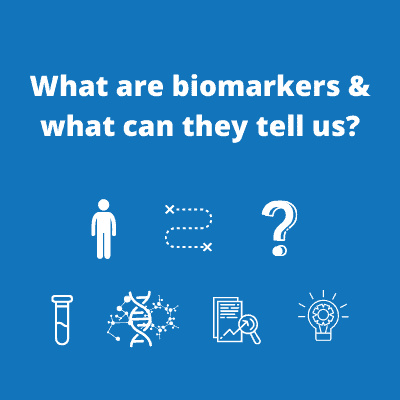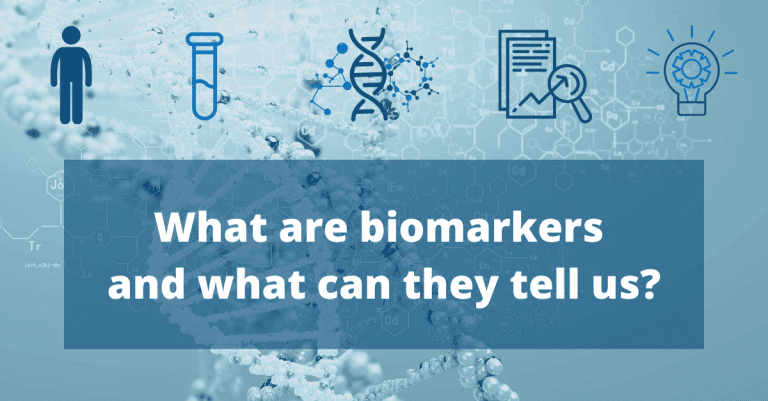Examples of biomarkers and biomarker data analysis
- 9th May 2022
- Posted by: Breige McBride
- Category: Biomarkers

Whether you want to know what a biomarker is, or if you are looking for biomarker data analysis, this blog is for you. If you are new to biomarkers, read on to learn all about them, their different types and what they can tell us. If you already know about biomarkers and just want to know more about biomarker data analysis, scroll to the bottom!

What is a biomarker?
A ‘biomarker’ (an amalgamation of ‘biological’ and ‘marker’) simply refers to a biological characteristic that we can measure and analyse to tell us something about an organism. There are numerous different kinds of biomarkers and they vary widely. For example, blood pressure, body temperature and body mass index are all biomarkers. However, biomarkers are not restricted to things that could be measured at a routine doctor’s appointment. For example, we can also consider the level of gene expression within cells, or proteins within bone, as biomarkers.
Examples of biomarkers
Since biomarkers can tell us information about an organism, they are frequently used in medical research. Some common categories of biomarkers that researchers refer to are clinical biomarkers, diagnostic biomarkers and molecular biomarkers. We explain these biomarker categories as well as some others below, with examples of each.
Clinical
Clinical biomarkers are biomarkers that are used in clinical research or in clinical practice. Therefore, all biomarkers can be considered clinical biomarkers when used for a clinical application. For example, pharmacodynamic biomarkers are clinical biomarkers when researchers monitor them as part of clinical research. Pharmacodynamic biomarkers indicate the occurrence of a biological response in someone who has been exposed to an environmental agent or medical product. This is why researchers can use them in drug discovery research; as well as in clinical trials and in clinical practice.
Often, researchers who are conducting clinical trials to test a new drug, don’t know which clinical biomarkers will be associated with particular patient outcomes. This is one area where biomarker data analysis can be useful. Biomarker data analysis uses data from the clinical trial to identify biomarkers which indicate particular outcomes. For example, researchers may want to know if the presence of a certain mutation can predict a patient’s response to a drug. Biomarker data analysis can confirm whether or not this is the case.
Antecedent
We can use antecedent biomarkers to evaluate the risk of an individual developing a certain illness. For example, Washington University is currently conducting a study into antecedent biomarkers of preclinical Alzheimer’s disease in order to identify those who are at high risk of developing symptomatic Alzheimer’s disease1. Antecedent biomarkers are also particularly helpful in enabling early diagnosis and/or prophylactic intervention.
Screening biomarkers
Medical researchers use screening biomarkers to screen for subclinical diseases (diseases which do not present definite or easily observable symptoms). For example, one way medical practitioners can conduct prenatal screening for Down’s syndrome is via ultrasound measurement of nuchal translucency2 (a collection of fluid under the skin behind the neck of a fetus). It is normal for a fetus to have a nuchal fold (pad of skin at the back of their neck) but when measurement of nuchal translucency indicates a thickened nuchal fold, this is suggestive of a high risk for Down’s syndrome.
Diagnostic
A diagnostic biomarker is a biomarker that helps us to diagnose a disease, by confirming the presence of that disease. For example, we can use a high blood sugar level as a diagnostic biomarker of Type 2 diabetes3.
Prognostic
Prognostics biomarkers have various applications. They can help us to predict the future progression of an individual’s disease, and how likely disease recurrence is. For example, we can use mutations to breast cancer genes 1 and 2 (BRCA1/2) to evaluate the probability of a second breast cancer4.
Imaging biomarkers
Imaging biomarkers are biomarkers (biological characteristics) that we can detect from an image. For example, metabolic active tumour volume, which we can see via a PET scan, is an imaging biomarker linked to survival in lung cancer5.
Molecular
A molecular biomarker is a non-imaging biomarker which has biophysical properties. Thanks to their biophysical properties, we can measure molecular biomarkers via biological samples, such as blood or cerebral fluid. For example, cholesterol levels in blood can act as molecular biomarkers for cardiovascular disease6.
What are biomarkers in cancer?
When people talk about cancer biomarkers they are usually referring to diagnostic or prognostic biomarkers. As explained above, prognostic biomarkers can be used to predict the extent of a disease. It is common to speak about some diseases, like cancers, in terms of stages as the disease progresses, to indicate how far the disease has progressed. In cancers, we mostly determine the stage of the cancer progression by looking at the anatomical extent of the cancer. However, research is moving towards determining if some biomarkers can indicate cancer stages7.
What is biomarker data?
Biomarker data can be any data which contains biological information about the organism. Since a biomarker is a biological characteristic that we can measure and analyse to tell us something about an organism; there are thousands of different biomarkers that can fall into one or more of the categories explained above. With so many different biomarkers, biomarker data can take many forms. For example, blood samples can contain biomarker data and PET scans can contain biomarker data.
What is biomarker data analysis?
Biomarker data analysis can require the use of bioinformatics – particularly in the clinical space when there are multiple data types and outputs to consider. This analysis can help identify biomarkers (biomarker discovery) to confirm they are suitable for a specific application such as diagnosis, prognosis or to associate biomarkers with a specific outcome such as survival.
Biomarker Data Analysis from Fios Genomics
At Fios, we have over a decade of experience in biomarker data analysis. We are particularly adept at biomarker discovery as we regularly conduct analyses for clients specifically for novel biomarker identification. Also, due to the popularity of our proteomics data analyses, our bioinformaticians are excellent at identifying and quantifying protein biomarkers associated with, for example, drug response or survival.
Our years of experience in biomarker data analysis are why clients keep coming back to us any time they need to identify biomarkers from clinical data. You can learn more about this on our clinical data analysis page. If you would like to discuss a biomarker data analysis project, please contact us. We are always happy to advise on analysis projects and answer any questions you may have.
Examples of Biomarkers Video
View this blog in video format below.
Author: Breige McBride, Content and Social Media Manager, Fios Genomics
Reviewed by Fios Genomics Bioinformatics Experts to ensure accuracy
More from Fios Genomics
Supporting biomarker discovery with bioinformatics
Leave a Reply
You must be logged in to post a comment.

